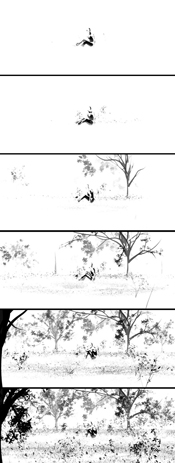
So it leads one on a path of questioning from the idea of a garden, a natural landscape painted on the earth artificially with dirt and plant matter, to the idea of an artificial snake who still sheds his skin and acts in all ways like a snake. Is this snake still a force of nature, responding to forces of nature? Are we within the uncanny valley, or have we passed back out of it? The true point of note would have to be in the path that would lead to this end, an end where our world is populated with non-organic life matter, acting in every way like their organic predecessors.
In Christian Volckman’s Renaissance 2054, nature presents its self on a very limited scale in rather limited situations. It seems a tool used to confuse or confound the character caught up within it. It almost seems that the scarcity of any natural forms renders the person of this world confused; unfamiliarity with the forest makes this terrain difficult to navigate. The reality of the forest in Jonas’ apartment contrasted with the virtual reality of the forest of Ilona’s capture again perpetuates this idea of nature existing only in an artificial sense, but the artificial of Renaissance moves one step further into a world of simulation. Nature here is a method of disorientation and does not exist as a destination of paradise.



